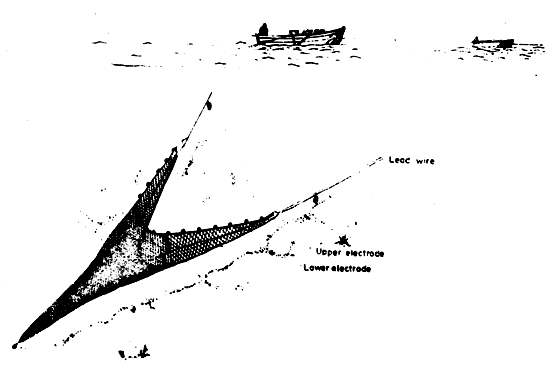by
Dr. W. Dembinśki
Instytut Rybactwa Środladowego
Olsztyn-Kortowo, Poland
and
Dr. A. Chmielewski
Politechnika Poznanśka
Poznań, Poland
The idea of catching eels in lakes by means of an electrified trawl was introduced to Poland from the Democratic Republic of Germany.
The prototype of the Polish trawl was constructed in 1967 in the Laboratory of Fishing Techniques (Inland Fisheries Institute in Olsztyn-Kortowo), which cooperated in this project with the Department of Rural Electrification (Poznań College of Technology). Tests under practical conditions were carried out in the summer of 1967 at the State Fish Farm “Gizycko”. The results obtained were good.
The so-called “classical” arrangement for electrical fishing, which is composed of an a.c. generator (driven by a petrol engine) and a rectifying unit, can be successful when fishing along the margins of the lakes, which are usually grown over (reeds, etc.). On the other hand, this electrified trawl makes it possible to catch eel in other parts of the lake.
Net portions of the trawl are formed in the shape of a sack with short wings (Fig. 1). The horizontal opening is about 8 m. Top and bottom lines are about 2 m apart and are fitted with electrodes. The electrical energy is supplied from the petrol-driven a.c. generator, 2 kVA, 230 V, 8,7 A (type PAB2-1/230), via a step down transformer and insulated electrical conductors fastened to one of the towing lines. No rectifiers or impulse units are used. The trawl is towed by two boats at the rate of about 1.5 km/h. The best boats for this purpose are those with Diesel engines, 5 hp each, fitted additionally with special belt transmission for board propulsion. In this case two people can operate the whole arrangement.
The length of the towing lines and the distance the boats are apart when towing depends on the depth of water. This relationship is given in Table I.
Table I
| Water depth in m | Length of towing lines in m | Distance the boats are apart, in m |
| 3 | 30 | 40 |
| 5 | 40 | 50 |
| 7 | 50 | 60 |
| 10 | 65 | 80 |
| 15 | 90 | 100 |
| 20 | 115 | 130 |
The electric field, built up in the plane of the trawl net mouth, paralyses the movements of any eel which is in its path. An escape becomes very difficult and the eel falls back into the sack located about 15 – 20 m away from the net mouth. Voltage gradients there are very low. This permits a quick recovery of the eel which is therefore in good condition, and reaches the market alive.
Fishing performance per one hour of towing depends on the poulation of eels in the area. The best result, so far, of 38 kg of eels per hour has been reached on the lake Gardno which is located very near to the Baltic sea coast. Its main characteristics are: surface area 2 468 ha, maximum depth 2.6 m, average depth 1.3 m, water conductivity 300 – 500 S/cm. If one takes into account that during the period of one hour a surface area of about 1 hectare can be fished, then the above result must be regarded as a good one.
REFERENCES
Hattop, H.W., 1965 1-Elektrische Fang und Sperrvorrichtungen sur Intensivbewirtschaftung von Seen. Deutsche Fischerei Zeitung Nr 6.
Dembiński, W. and A. 1967 Chmielewski Elektryczna tuka wegorzowa. Gospodarka Rybna Nr. 9
Predel G., 1968 Vergleichende Untersuchungen mit einem elektrischen Schleppnetz bei Verwendung verschiedener Stromarten. Deutsche Fishcherei Zeitung, Nr 10.
